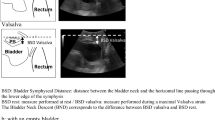Abstract
The aim of the study was to determine, using perineal ultrasound, the physiological range for urethral mobility in normal women. Sixty healthy women were enrolled. The ultrasound parameters obtained with a perineal “static” and “dynamic” evaluation method were: pubic–urethral distance and inclination angle of the urethral axis. We propose a physiological range of pubic–urethral distance under stress in young women between 10 and 15 mm, the inclination angle of the urethral axis is between 60 and 100°. In peri–post-menopause women we establish a non-rigid range of mobility in relation to age and parity: between 15 and 18 mm for the pubis–urethra distance and 80° and 120° for the angle of the urethral axis. Defining a range of normality for urethral mobility through ultrasound is useful for further studying therapeutic choices and help to identify the surgical correction and post-operative follow-up.



Similar content being viewed by others
References
Dietz HP (2004) Ultrasound imaging of the pelvic floor. Part I: two-dimensional aspects. Ultrasound Obstet Gynecol 23:80–92
Sarnelli G, Trovato C, Imarisio M, Talleri D, Barconi A (2003) L’indagine ecografica del perineo femminile. La radiologia medica 106:357–359
Schaer GN, Koechli OR, Schuessler B, Haller U (1996) Perineal ultrasound: determination of reliable examination procedures. Ultrasound Obstet Gynecol 7:347–352
Dietz HP, Haylen BT, Broome J (2001) Ultrasound in the quantification of female pelvic organ prolapse. Ultrasound Obstet Gynecol 18:511–514
Schaer GN, Koechli OR, Schuessler B, Haller U (1995) Perineal ultrasound for evaluating the bladder neck in urinary stress incontinence. Obstet Gynecol 85:220–224
Granados Loarca EA, Alcahe VR, de Leon Lopez H, Echeverria Reyes J (1999) The usefulness of perineal ultrasound in urinary incontinence in women. Arch Esp Urol 52:778–782
Chen GD, Su TH, Lin LY (1997) Applicability of perineal sonography in anatomical evaluation of bladder neck in women with and without genuine stress incontinence. J Clin Ultrasound 25:189–194
Sarnelli G, Carone R, Biroli A (1999) L’ecografia perineale dinamica nello studio dell’incontinenza urinaria femminile. Urologia Pratica 3:77–84
Tunn R, Petri E (2003) Introital and transvaginal ultrasound as the main tool in the assessment of urogenital and pelvic floor dysfunction: an imaging panel and practical approach. Ultrasound Obstet Gynecol 22:205–213
Dietz HP, Wilson PD (1996) Anatomical assessment of the bladder outlet and proximal urethra using ultrasound and videocystourethrography. Neurourol Urodyn 15:363–364
Acknowledgements
This study was supported by a grant from the Second University of Naples. Special thanks to Georgina Ellison for English language translation.
Conflicts of interest
None.
Author information
Authors and Affiliations
Corresponding author
Rights and permissions
About this article
Cite this article
Di Pietto, L., Scaffa, C., Torella, M. et al. Perineal ultrasound in the study of urethral mobility: proposal of a normal physiological range. Int Urogynecol J 19, 1405–1409 (2008). https://doi.org/10.1007/s00192-008-0644-5
Received:
Accepted:
Published:
Issue Date:
DOI: https://doi.org/10.1007/s00192-008-0644-5




